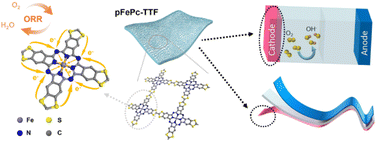Donor–acceptor iron phthalocyanine-based hyper-crosslinked polymers with a modulated electronic structure for efficient oxygen reduction reaction in aluminum–air batteries†
Abstract
Iron phthalocyanine (FePc) with an ideal N-coordinated environment has been regarded as a promising catalyst for the oxygen reduction reaction (ORR). However, its self-aggregation and inferior stability remain to be solved for further application. Herein, poly-FePc-based hyper-crosslinked polymers with tetrathiafulvalene (TTF) modification (named pFePc-TTF) are innovatively constructed and applied as an efficient ORR catalyst for aluminum–air batteries (AABs). Thanks to the donor (TTF)–acceptor (FePc) effect, the resultant pFePc-TTF catalyst exhibits satisfactory ORR activity with a half-wave potential of 0.90 V, a four-electron transfer process, methanol tolerance, and excellent stability in alkaline electrolytes. The improved electrocatalytic performance might be ascribed to the introduction of TTF as an electron donor, which effectively modulates the electron distribution of the Fe atom and optimizes the absorption energy of intermediate species. As expected, both liquid AABs and all-solid-state flexible AABs equipped with pFePc-TTF display outstanding battery performance in comparison to those equipped with commercial Pt/C. This novel metal macrocycle-based compound provides an effective strategy for the design of efficient and durable ORR catalysts for energy-related applications.



 Please wait while we load your content...
Please wait while we load your content...